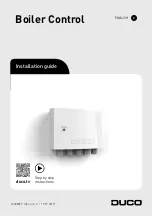
Tx Series Installation and Operation Instructions
│
Trinity
67
Setting Description
Factory
Setting
2-12
Minimum firing rate
– allows the installer to increase the minimum modulation/firing rate of the
boiler; this may be necessary for troubleshooting. Range = 20-44%
20%
2-13
Maximum firing rate CH
– allows the installer to decrease the maximum modulation/firing rate of
the boiler when operating on a central heat demand; this may be necessary for troubleshooting or de-
rating the boiler for operation with glycol. Range = 60-100%
100%
2-15
Firing rate test
– allows the installer to force maximum or minimum modulation rates for the purpose
of troubleshooting and burner setup (i.e. combustion analysis):
0 = Automatic; burner modulation is controlled by the controller.
1 = Minimum; burner operates at the minimum modulation rate.
2 = Ignition; burner operates at the ignition/light-off modulation rate.
3 = Maximum; burner operates at the maximum modulation rate.
Note: control will end test (return setting to 0) if the boiler outlet temperature exceeds 176
⁰
F. Return
setting to 0 when testing is complete.
0
2-16
Service reminder status
– feature not available with first generation Tx boilers.
OFF
2-17
Boiler pump postpurge
– length of time the Boiler Pump output remains powered once all demands
end. Range = 10-90seconds
30 sec
2-18
CH pump postpurge
– length of time the CH Pump output remains powered at the end of a central
heat demand. Range = 0-90seconds
30 sec
2-19
DHW pump postpurge
– length of time the DHW Pump output remains powered at the end of a
DHW demand. Range = 0-255seconds
10 sec
2-20
Cascade boiler address
– assign a unique boiler address for each boiler in a cascade; managing boiler
address must be set to 1. Managing boiler must have S4 switch set to ON; all others must be set to
OFF. Central heat and DHW demands and setpoints are received and set at the managing boiler only.
A boiler that is not part of a cascade must have the boiler address set to 0.
Range = 0-16
0
2-21
Emergency setpoint
– used only for a cascade system, assigns a permanent boiler operating
temperature that is used if communication between boilers is lost, or if the system temperature sensor
becomes disconnected. Range = 104-190
⁰
F
113
⁰
F
2-22
Rotation interval
– establishes the time between the rotation of start and stop sequences of boilers in
a cascade. Range = 0-30days (0=disable)
5 days
2-23
DHW boiler address
– feature not available with first generation Tx boilers.
NA
2-24
System pump postpurge
– feature not available with first generation Tx boilers.
NA
2-25
Flame failures
– accumulation of the number of flame outages that occurred during run.
NA
2-26
Ignition attempts success
– accumulation of the number of successful ignitions.
NA
2-27
Ignition attempts failed
– accumulation of the number of failed ignition attempts.
NA
2-28
Run time CH
– accumulation of the number of hours that the burner has been firing for the purpose
of central heating.
NA
2-29
Run time DHW
– accumulation of the number of hours that the burner has been firing for the purpose
of DHW.
NA
2-30
Post purge time
– length of time the combustion blower operates at the end of a burner sequence.
Recommend increasing post purge time for installations with long exhaust venting.
Range = 5-60seconds
15 sec
2-31
Units selection
– allows the installer to select US or metric units. Range =
⁰
F or
⁰
C
⁰
F
2-32
External Ignition –
future consideration. Range = On or OFF
OFF














































